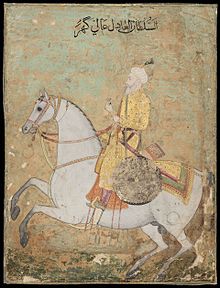Shah Alam II
Jalal ad-Din Abul Mozaffar Mohammad Ali Gauhar (born June 15, 1728 ; † November 10, 1806 in Delhi ) was Shah Alam II. Emperor of the Indian Mughal Empire from 1759 to 1806. He was the eldest son of Alamgir II.
During a power struggle between two of his father's ministers, who were supported by the Marathas and the Afghan Durrani , he fled Delhi to Bihar in 1758 . After his father was murdered in Delhi on November 29, 1759, Shah Jahan III climbed the hill. , a great-grandson of Aurangzeb , took the throne, but was deposed after a short reign. December 24, 1759 - Shah Jahan III. was still in office - Shah Alam proclaimed himself emperor. After his defeat in the Battle of Baksar in November 1764, he was assigned to Bengal , Bihar and Orissa of the British East India Companyleft. In exile in Allahabad , with the help of the Safavid nobleman Mirza Najaf Khan, he concluded a treaty with the Marathas on February 15, 1771, who were to conquer Delhi in his name and receive four million rupees for it. On January 6, 1772 he managed to return to Delhi. Thanks to Mirza Najaf Khan, he was able to push back the Sikhs in the Punjab , but due to financial difficulties he was unable to extend the rule of the Mughal Empire beyond the Delhi area. The proverb established itself for this: The empire of Shah Alam extends from Delhi to Palam (Persian Saltānat-e Shāh 'Ālam az Dillī tā Palam ). Next to Palam is now the Delhi airport.
In 1788 the Afghan Ghulam Qadir invaded Delhi. Shah Alam was deposed, captured and blinded a few days later on July 31st . In his place, Baidar Bakht was proclaimed emperor. After the Marathas expelled Ghulam Khadir and Baidar Bakht from Delhi, they put the blind Shah Alam back on the throne in 1789. When the power of the Marathas was broken in the Second Marath War , Shah Alam had to accept the patronage of the British East India Company on August 29, 1803. Its territory was annexed and control of it was placed under a British resident . However, he was allowed to continue to use the title of ruler Padshah and reside in the Red Fort of Delhi. He was granted a pension by the British.
literature
- Hans-Georg Behr : The Mughals. Power and splendor of the Indian emperors from 1369-1857 . Econ Verlag, Vienna-Düsseldorf 1979.
Web links
Individual evidence
- ↑ Kulke, Herrman, and Rothermund, Dietmar: History of India , 3rd ed. London and New York: Routledge, 1998, p. 220.
| predecessor | Office | successor |
|---|---|---|
| Shah Jahan III. |
Mughal emperor of India 1759 - 1806 |
Akbar Shah II. |
| personal data | |
|---|---|
| SURNAME | Shah Alam II |
| ALTERNATIVE NAMES | Jalal ad-Din Abul Mozaffar Mohammad Ali Gauhar |
| BRIEF DESCRIPTION | Mughal Mughal of India |
| DATE OF BIRTH | June 15, 1728 |
| DATE OF DEATH | November 10, 1806 |
| Place of death | Delhi , India |
